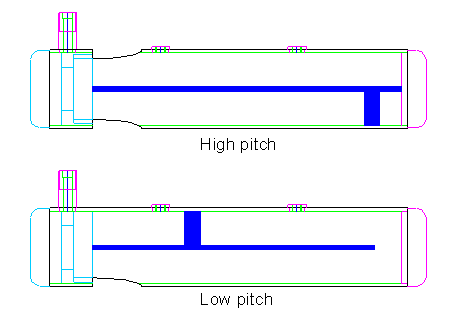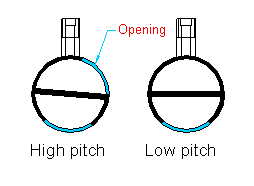< Whistles 1 >
As William is rather small model, I have
neither enough space for a big whistle nor
enough steam to drive it. However I wish
to have deep tone and at least three-note
chime, and also pitch-bending whistle like
a full size one. So I will try as hard as
I can.
 Steam whistle pitch is determined due to
following formula.
Steam whistle pitch is determined due to
following formula.
tube length + 'open-end correction' = 1/4
* wavelength
The open-end correction depends on whistle
construction and steam pressure. As the pressure
rises, the open-end correction decreases
and whistle pitch increases. Therefore if
you wish pitch-bending, you have to prepare
a whistle with wide range of pressures.
In proportion to the steam pressure, opening
length or gap width should be larger. 'U'
shape or oval shape opening makes the length
ambiguous. As a result, they can resonate
with wide range of pressure. Triangle shape
opening is identical but it makes poor sound.
Opening length and gap width can be adjusted
as follows. If they are too small the whistle
resonate with shrill voice (the third harmonic),
and if too large the whistle sounds poor
and husky. You can start with a small gap
and increase it until the third harmonic
sound disappears. It should be done with
maximum steam from your boiler, instead of
your breath. Incidentally, opening area should
be smaller than the section area of the tube.
If it is too small, you have to increase
tube diameter itself.
Chime whistle doesn't sound like a chime
without good volume balance. Due to the above-mentioned
reason, the opening or the gap only control
the sound quality, not the sound volume.
Volume control should be done by steam volume
itself for each whistle, adjusting tube diameter
or inserting orifices.
To return to my William, there is no space
for the whistle between the main frames,
so I arranged to mount two whistles under
the both running boards, simulating compressed
air containers. Maximum size is 25mm dia.
and 100mm length. Each whistle tube is divided
into two parts by partition plate. One of
the whistles generates higher two notes and
the other has a turn back at the bottom to
generate one deep note. I referred several
chords of full size locomotive chime whistles
and chose a chord 'C-G-Bb'. The middle note
is determined by the tube length. The top
and bottom notes are adjustable with positioning
of half-round plates.


The higher two-note whistle has two openings
in opposite side, upper and lower. I shifted
the upper opening toward the edge of partition
plate and also slightly tilted the plate,
so as to allow condensed water to drain out
of the tube.
A tube-cutter which was employed to cut the
whistle tube from a long brass tube.
The oval-shaped openings was filed out, starting
with a round file moving across the tube
till the tube skin breaks and following with
half round or flat file to get desired shape.
Two bushes and one stud were silver soldered
onto the whistle. The former is for fixing
the whistles under the running boards and
the latter is for steam connecting from whistle
valve.
The front plug is integrated to the gap-control
disc. The groove between them is as a steam
chest.
The gap is milled in a jig on the rotary
table. The jig has round recess close-fitting
to the plug. I started with 0.2mm gap for
each note.
The partition plate is made from 1.5mm brass
sheet. Each plug have 1.6mm slit to hold
both end of the plate.
Before steaming up for adjustment, it is
worth testing with a bicycle tire pump. Press
the pump handle as fast as you can, then
you get a boiler pressure. I prepared branched
tube from whistle valve to whistles in advance,
then connected two whistles together and
let them go. The lower one-note whistle was
louder than the others. Therefore I introduced
a micro brass tube into the steam stud as
an orifice. Then the volumes became well
balanced.
| TOP | BACK | NEXT |